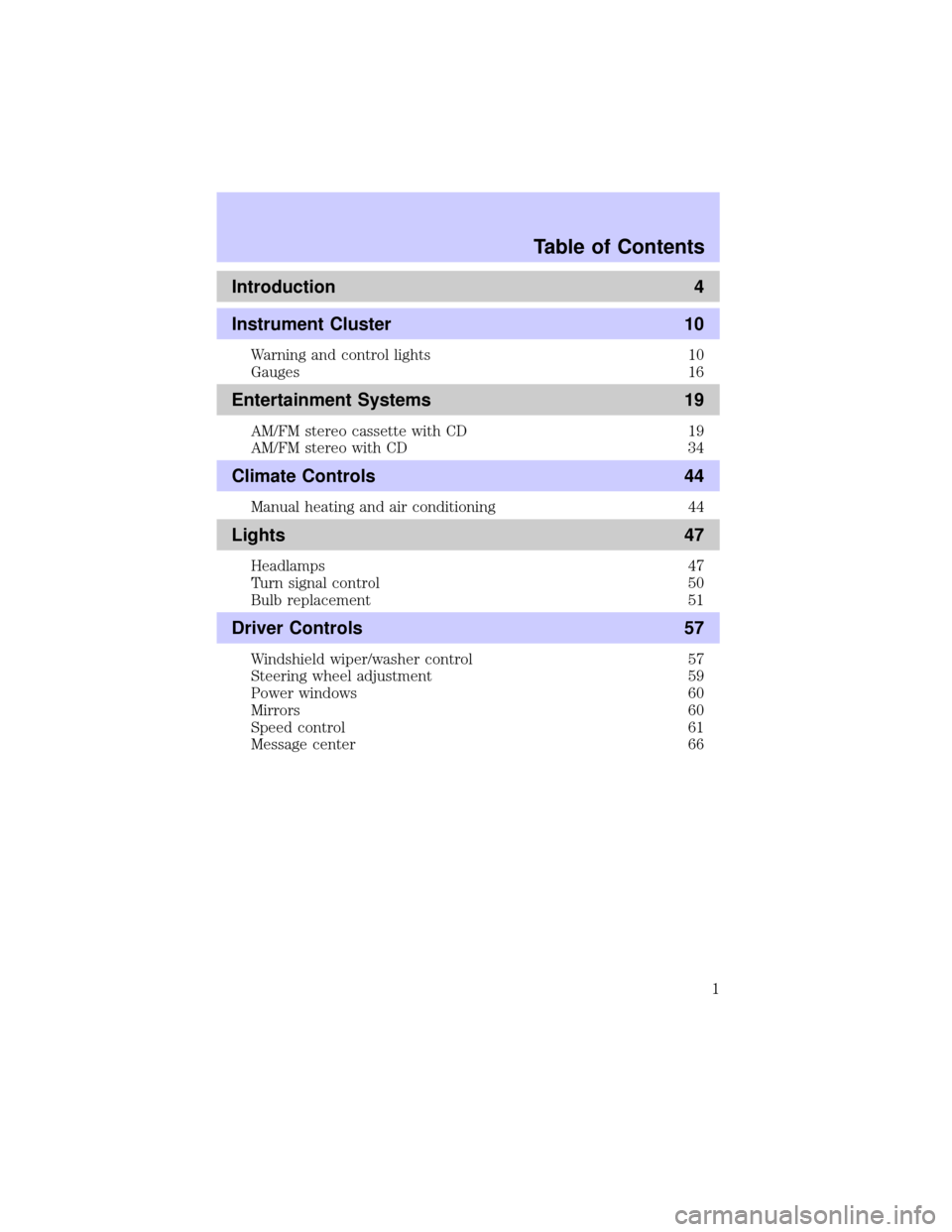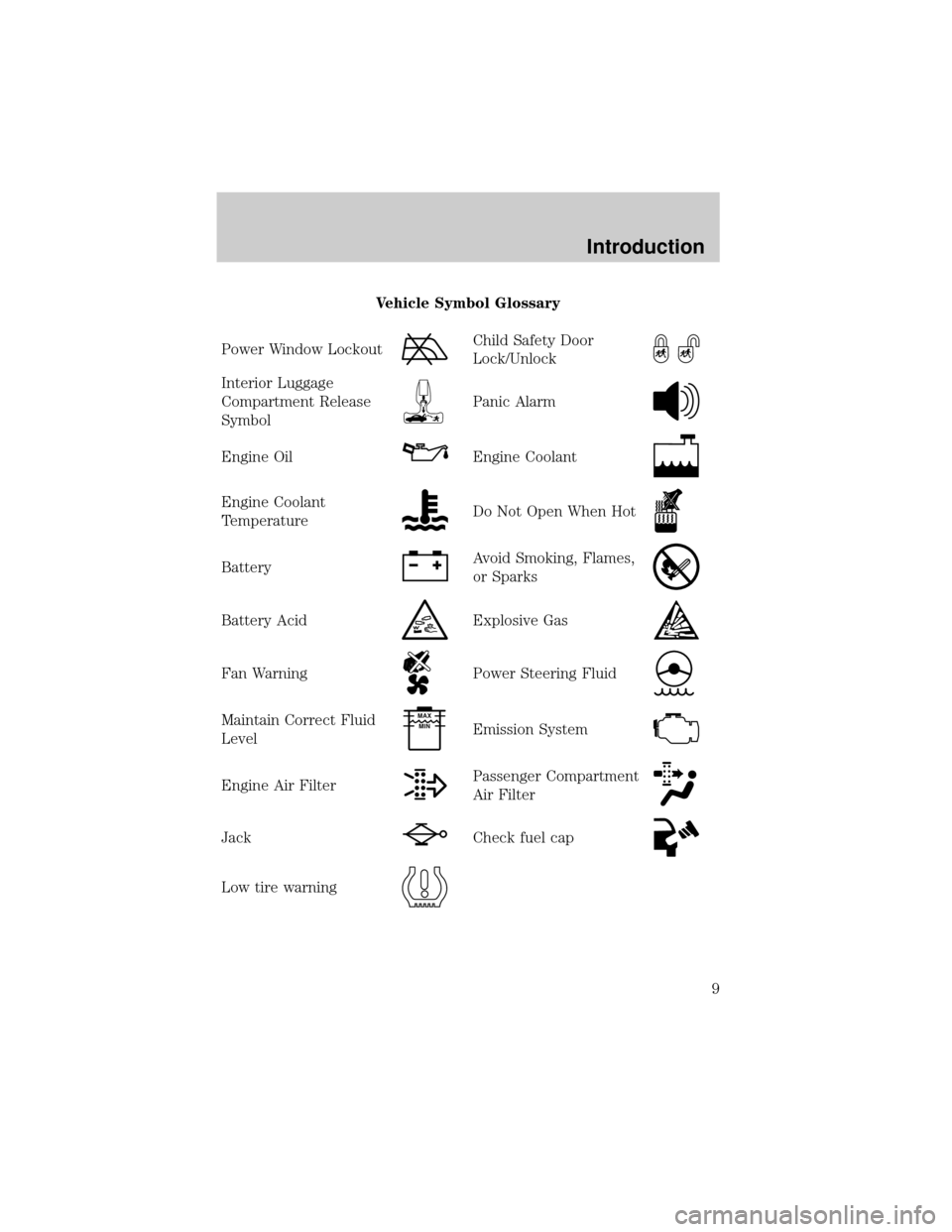power steering Mercury Mercury Cougar 2002 Owner's Manual
[x] Cancel search | Manufacturer: MERCURY, Model Year: 2002, Model line: Mercury Cougar, Model: Mercury Mercury Cougar 2002Pages: 216, PDF Size: 4.04 MB
Page 1 of 216

Introduction 4
Instrument Cluster 10
Warning and control lights 10
Gauges 16
Entertainment Systems 19
AM/FM stereo cassette with CD 19
AM/FM stereo with CD 34
Climate Controls 44
Manual heating and air conditioning 44
Lights 47
Headlamps 47
Turn signal control 50
Bulb replacement 51
Driver Controls 57
Windshield wiper/washer control 57
Steering wheel adjustment 59
Power windows 60
Mirrors 60
Speed control 61
Message center 66
Table of Contents
1
Page 9 of 216

Vehicle Symbol Glossary
Power Window Lockout
Child Safety Door
Lock/Unlock
Interior Luggage
Compartment Release
Symbol
Panic Alarm
Engine OilEngine Coolant
Engine Coolant
TemperatureDo Not Open When Hot
BatteryAvoid Smoking, Flames,
or Sparks
Battery AcidExplosive Gas
Fan WarningPower Steering Fluid
Maintain Correct Fluid
LevelMAX
MIN
Emission System
Engine Air FilterPassenger Compartment
Air Filter
JackCheck fuel cap
Low tire warning
Introduction
9
Page 112 of 216

STARTING
Positions of the ignition
1. LOCK, locks the steering wheel,
gearshift lever (automatic transaxle
only) and allows key removal. On
vehicles with a manual transaxle
push the key in while turning to
lock.
2. ACCESSORY, allows the electrical
accessories such as the radio to
operate while the engine is not
running.
3. ON, all electrical circuits operational. Warning lights illuminated. Key
position when driving.
4. START, cranks the engine. Release the key as soon as the engine
starts.
Preparing to start your vehicle
Engine starting is controlled by the powertrain control system. This
system meets all Canadian Interference-Causing Equipment standard
requirements regulating the impulse electrical field strength of radio
noise.
When starting a fuel-injected engine, avoid pressing the accelerator
before or during starting. Only use the accelerator when you have
difficulty starting the engine. For more information on starting the
vehicle, refer toStarting the enginein this chapter.
Extended idling at high engine speeds can produce very high
temperatures in the engine and exhaust system, creating the risk
of fire or other damage.
Do not park, idle, or drive your vehicle in dry grass or other dry
ground cover. The emission system heats up the engine
compartment and exhaust system, which can start a fire.
Do not start your vehicle in a closed garage or in other enclosed
areas. Exhaust fumes can be toxic. Always open the garage door
before you start the engine. SeeGuarding against exhaust fumesin
this chapter for more instructions.
Driving
112
Page 120 of 216

The Traction Controlyon/off
switch, located in the center of the
instrument panel illuminates when
the system is OFF. The Traction
Controlysystem will revert to the
ON position every time the ignition
is turned OFF and ON.
If you should become stuck in snow
or ice or on a very slippery road surface, try switching the Traction
Controlysystem off. This may allow excess wheel spin to ªdigº the
vehicle out and enable a successful ªrockingº maneuver.
If a system fault is detected the OFF indicator lamp on the traction
control switch will be illuminated and your vehicle should be serviced.
STEERING
Your vehicle is equipped with power steering. Power steering uses energy
from the engine to decrease the driver's effort in steering the vehicle.
To prevent damage to the power steering pump:
²Never hold the steering wheel to the extreme right or the extreme left
for more than a few seconds when the engine is running.
²Do not operate the vehicle with the power steering pump fluid level
below the MIN mark on the reservoir.
If the power steering system breaks down (or if the engine is turned
off), you can steer the vehicle manually, but it takes more effort.
If the steering wanders or pulls, the condition could be caused by any of
the following:
²Underinflated tire(s) on any wheel(s)
²Uneven vehicle loading
²High crown in center of road
²High crosswinds
²Wheels out of alignment
²Loose or worn suspension components
AUTOMATIC TRANSMISSION OPERATION (IF EQUIPPED)
Brake-shift interlock
If you cannot move the gearshift lever out of P (Park) with the brake
pedal depressed:
Driving
120
Page 142 of 216

Fuse/Relay
LocationFuse Amp
RatingPower Distribution Box
Description
R8 Ð High speed engine cooling fan
R9 Ð Engine cooling fan
R10 Ð Not used
R11 Ð Daytime running lamps (Canada
only)
D1 Ð Starter relay
D2 Ð Air conditioning
* Have these fuses replaced by your dealer or qualified technician.
CHANGING THE TIRES
If you get a flat tire while driving, do not apply the brake heavily.
Instead, gradually decrease your speed. Hold the steering wheel firmly
and slowly move to a safe place on the side of the road.
The use of tire sealants is not recommended and may compromise the
integrity of your tires. The use of tire sealants may also affect your tire
pressure monitoring system (if equipped).
Temporary spare tire information
The temporary spare tire for your vehicle is labeled as such. It is smaller
than a regular tire and is designed for emergency use only.
If you use the temporary spare tire continuously or do not follow
these precautions, the tire could fail, causing you to lose control
of the vehicle, possibly injuring yourself or others.
When driving with the temporary spare tiredo not:
²use more than one temporary spare tire at a time
²exceed 80 km/h (50 mph) or drive further than 3 200 km (2 000
miles) total under any circumstances
²load the vehicle beyond maximum vehicle load rating listed on the
Safety Compliance Label
²tow a trailer
²use tire chains
²drive through an automatic car wash, because of the vehicle's reduced
ground clearance
Roadside Emergencies
142
Page 170 of 216

IDENTIFYING COMPONENTS IN THE ENGINE COMPARTMENT
2.0L I4 engine
1. Power steering fluid reservoir
2. Brake fluid reservoir
3. Air filter assembly
4. Power distribution box
5. Battery
6. Engine oil filler cap
7. Engine oil dipstick
8. Engine coolant reservoir
9. Windshield washer fluid reservoir
123
456789
Maintenance and Specifications
170
Page 171 of 216

2.5L V6 engine
1. Power steering fluid reservoir
2. Automatic transmission fluid dipstick (if equipped)
3. Brake fluid reservoir
4. Air filter assembly
5. Power distribution box
6. Battery
7. Engine oil filler cap
8. Engine oil dipstick
9. Engine coolant reservoir
10. Windshield washer fluid reservoir
1234
5781096
Maintenance and Specifications
171
Page 190 of 216

permitted to intentionally remove an emission control device or prevent
it from working. Information about your vehicle's emission system is on
the Vehicle Emission Control Information Decal located on or near the
engine. This decal identifies engine displacement and gives some tune up
specifications.
Please consult yourWarranty Guidefor complete emission warranty
information.
Readiness for Inspection/Maintenance (I/M) testing
In some localities, it may be a legal requirement to pass an I/M test of
the on-board diagnostics system. If your ªCheck Engine/Service Engine
Soonº light is on, refer to the description in theWarning lights and
chimessection of theInstrument clusterchapter. Your vehicle may not
pass the I/M test with the ªCheck Engine/Service Engine Soonº light on.
If the vehicle's powertrain system or its battery has just been serviced,
the on-board diagnostics system is reset to a ªnot ready for I/M testº
condition. To ready the on-board diagnostics system for I/M testing, a
minimum of 30 minutes of city and highway driving is necessary as
described below:
²First, at least 10 minutes of driving on an expressway or highway.
²Next, at least 20 minutes driving in stop-and-go, city-type traffic with
at least four idle periods.
Allow the vehicle to sit for at least eight hours without starting the
engine. Then, start the engine and complete the above driving cycle. The
engine must warm up to its normal operating temperature. Once started,
do not turn off the engine until the above driving cycle is complete.
CHECKING AND ADDING POWER STEERING FLUID
Check the power steering fluid.
Refer to the scheduled maintenance
guide for the service interval
schedules. If adding fluid is
necessary, use only MERCONtAT F.
1. Start the engine and let it run until it reaches normal operating
temperature (the engine coolant temperature gauge indicator will be
near the center of the normal area between H and C).
Maintenance and Specifications
190
Page 199 of 216

REFILL CAPACITIES
Fluid Ford Part Name Application Capacity
Brake fluid Motorcraft High
Performance DOT
3 Motor Vehicle
Brake FluidAll Fill to MAX mark
Engine coolant
1Motorcraft
Specialty Orange
Engine Coolant2.0L engine 6.6L (7.0 quarts)2
2.5L engine 9.5L (10.0
quarts)2
9.7L (10.2
quarts)3
Engine oil
(includes filter
change)Motorcraft SAE
5W-20 Premium
Synthetic Blend
Motor Oil2.0L engine 4.25L (4.5 quarts)
2.5L engine 5.5L (5.8 quarts)
Fuel tank
capacityN/A All 58.5L (15.4
gallons)
Power steering
fluidMotorcraft
MERCONtAT FAll Fill to MAX mark
Transmission
fluid
4Motorcraft
MERCONtAT FAutomatic
transaxles49.6L (10.2 quarts)
Motorcraft Full
Synthetic Manual
Transmission FluidManual
transaxles
52.6L (2.7 quarts)
Windshield
washer fluidUltra-Clear
Windshield Washer
ConcentrateAll Fill to top of
reservoir
1Add the coolant type originally equipped in your vehicle.
2Total capacity.
3With automatic transaxle.
4Ensure the correct automatic transmission fluid is used. Transmission
fluid requirements are indicated on the dipstick or on the dipstick
handle. MERCONtand MERCONtV are not interchangeable. DO NOT
mix MERCONtand MERCONtV. Refer to your scheduled maintenance
guide to determine the correct service interval.
5Service refill capacity is determined by filling the transmission to the
bottom of the filler hole with the vehicle on a level surface.
Maintenance and Specifications
199
Page 200 of 216

LUBRICANT SPECIFICATIONS
ItemFord Part
Name or
EquivalentFord Part
NumberFord
Specification
Brake fluid Motorcraft High
Performance
DOT 3 Motor
Vehicle Brake
FluidPM-1 ESA-M6C25-A
and DOT 3
Door latch, hood
latch, auxiliary
hood latch,
trunk latch, seat
tracks.Multi-Purpose
GreaseXG-4 or
F5AZ-19G209-AAESR-M1C159-A
Lock cylinder Penetrating and
Lock LubricantXL-1 none
Automatic
transaxleMotorcraft
MERCONtAT FXT-2-QDX MERCONt
Manual transaxle Motorcraft Full
Synthetic
Manual
Transmission
FluidXT-M5-QS WSD-M2C200±C
Engine oil Motorcraft SAE
5W-20 Premium
Synthetic Blend
Motor OilXO-5W20-QSP WSS-M2C153-H
and API
Certification
Mark
Constant
velocity jointsCV Joint Grease
(High Temp.)XG-2 ESP-M1C207-A
Engine coolant Motorcraft
Specialty Orange
Engine CoolantVC-2 WSS-M97B44±D
Power steering
fluidMotorcraft
MERCONtAT FXT-2-QDX MERCONt
Windshield
washer fluidUltra-clear
Windshield
Washer
ConcentrateC9AZ-19550-AC ESR-M17P5-A
Maintenance and Specifications
200